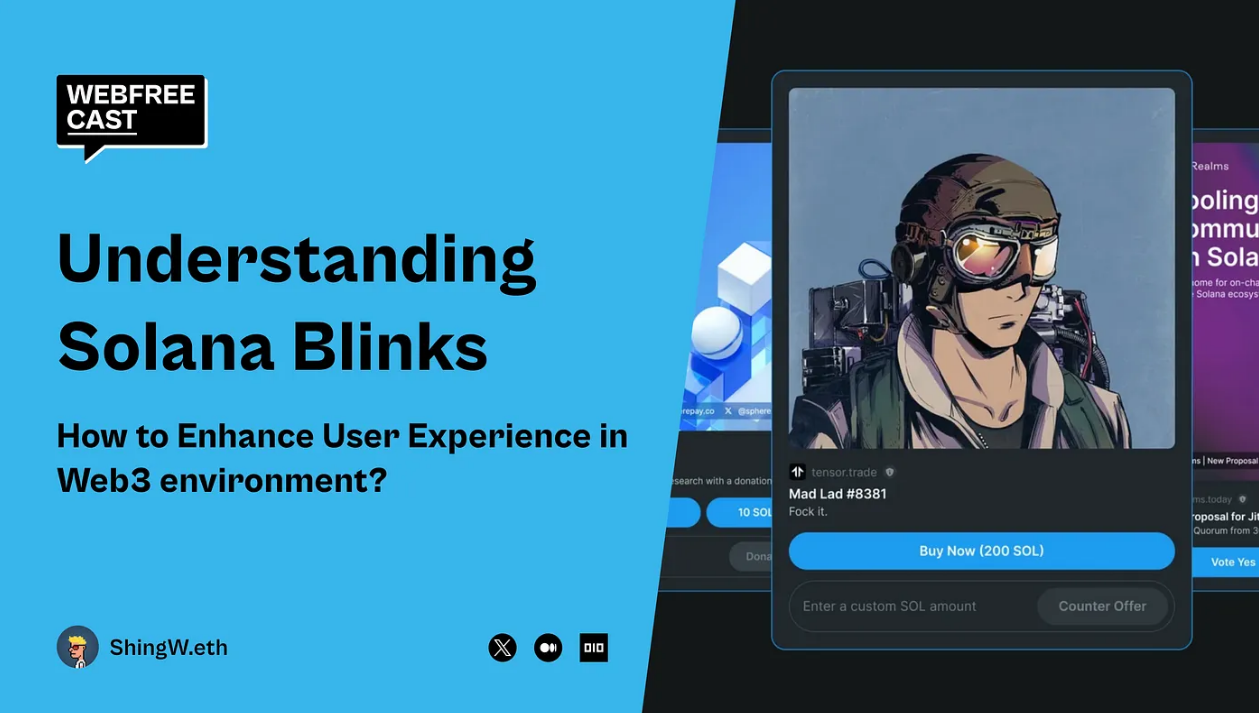Solana's Blinks technology simplifies blockchain operations and lowers the user threshold, improving the user experience and conversion rate for Web3 projects and NFT creators by sharing links.
Author: ShingW.eth
Translation: Blockchain in Plain Language

Recently, a new and practical technology has emerged in the Web3 and blockchain technology field - Solana blockchain links, abbreviated as Blinks. The special feature of this technology is how it transforms complex blockchain operations into a concise and clear link-sharing experience, thereby lowering the threshold for user blockchain operations. In this article, I will provide a detailed introduction to this technology and point out the various problems that Blinks can solve in Web3.

1. What is Blinks?
Blinks (blockchain links) is an innovative tool launched by the Solana blockchain, which can be shared on different social platforms such as Twitter and Telegram. With the small tool generated by Blinks, users can perform different on-chain operations in a simple and clear interface, making the entire complex process smoother and simpler. Compared to traditional methods, users can immediately complete the entire blockchain transaction process on social platforms using Blinks, greatly reducing the threshold for blockchain operations. When I saw the introduction and illustrations of Blinks on the Solana website, I was very impressed. I believe that Blinks can effectively solve the current problems in Web3.

2. Working Principle of Blinks
Blinks processes on-chain transactions for each application through the standard API of Solana Actions and uses URLs to execute sending and operations, recording the entire transaction process, allowing users to approve and sign transactions directly from the Solana wallet during the process.

3. Application Scenarios and Advantages of Blinks
With Blinks, Web3 projects or NFT creators can provide a more accessible platform for ordinary users, expanding their user base. For example, users can easily purchase NFTs, participate in prediction markets, check airdrop information, and engage in interactive games through Blinks. These activities originally required high technical thresholds and complex operational steps, but can now be completed through Blinks without the need for learning, greatly enhancing the user experience and effectively increasing user traffic.

From Solana's official documentation, it can be seen that Blinks technology currently supports most Web2 social software and can be integrated into platforms with corresponding design styles. Using the corresponding design style processing can enhance the user experience and confidence, making them more convinced that the relevant components are not phishing software.
4. Related Projects of Blinks?
After Solana launched Blinks technology, it sparked heated discussions on Twitter. The most famous is a Twitter account called SEND (@thesendcoin), which showcased as many as 50 examples and use cases of Blinks on the platform.

Later, the project used the functionality of Blinks to launch a series of 100,000 Send It NFTs, with a base price as high as 0.42 SOL. The project immediately launched a token economy. Based on the on-chain operations of the project, it is very likely that the SEND project is operated by internal personnel of Solana, and then Blinks was just launched to hype this hot topic.

5. What Problems Does Blinks Solve?
Although Blinks technology is relatively new at present, many projects are seizing this opportunity to gain visibility. However, in the long run, I believe that Blinks technology can effectively solve the problems currently faced by Web3. One of the problems that Web3 projects currently face is very low user conversion rates.
Currently, when we conduct different transactions, users need to constantly switch between different websites. For example, when we purchase Solana NFTs, we need to open Magic Eden. When we want to exchange tokens, we need to go to Raydium. When we want to borrow money, we need to go to Solend, and even when using SOL as liquidity collateral, we need to go to Jito. These switches affect the user experience every time, especially for users who are less familiar with Web3.

Using Blinks can effectively solve the problem of user conversion rates, greatly lowering the user threshold. Creating components using the API on Solana Actions can provide a smoother experience for users.

In addition to the user experience, Blinks also brings simpler and more direct solutions for project development and operation teams. Operation teams can more effectively promote projects using Blinks components and attract users through different experiences. From the perspective of the development team, Blinks provides more standardized modules for reference, effectively reducing development difficulty and time.

Based on the above content, although Solana Blinks is still a very new technology, I believe that many projects will develop and gain visibility from it. However, in the long run, I believe that the development of Blinks technology can bring a more user-friendly experience. I hope that in the future, in addition to the Solana chain, we can also see similar technological developments.
Original article link: https://www.hellobtc.com/kp/du/07/5317.html
Source: https://medium.com/shingw-eth/understanding-solana-blinks-how-to-improve-the-web3-experience-1f027cdd4f09
免责声明:本文章仅代表作者个人观点,不代表本平台的立场和观点。本文章仅供信息分享,不构成对任何人的任何投资建议。用户与作者之间的任何争议,与本平台无关。如网页中刊载的文章或图片涉及侵权,请提供相关的权利证明和身份证明发送邮件到support@aicoin.com,本平台相关工作人员将会进行核查。




